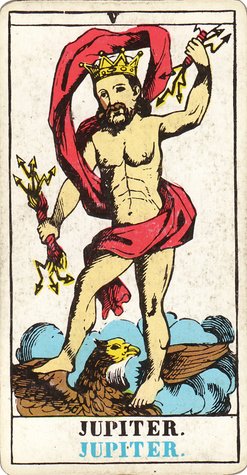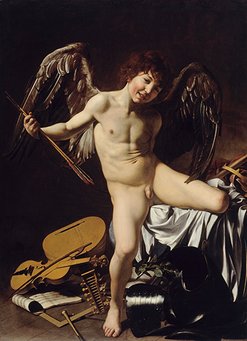THE TAROT WHEEL
THE MICHELINO DECK - A 5TH SUIT WITH 16 TRUMP CARDS
Pier Candido Decembrio, a man close to the Italian nobility, wrote a biography of the life of the Duke of Milan in 1447, shortly after Filippo Maria Visconti's death. This work describes how Filippo Maria and his court loved to invent new card games and new card decks. The Duke was a very shy and introverted person who hated mass manifestations (like triumphal processions) but loved strategic games (like chess and card games). Sometime between 1420 and 1425, the young Duke Filippo Maria asked Marziano Rampini di Sancto Aloisio, better known as Marziano da Tortona, to create for him a pack of cards with a new concept. A possible reason for the creation of this pack could have been the announced birth of his future son, who turned out to be a girl at birth (Bianca Maria Visconti, 1423). It is possible that, in view of this imminent birth, he commissioned Marziano da Tortona to make the deck in order to glorify his family and his ancestors.
Marziano da Tortona was a well-educated man with a good knowledge of classical antiquity and astrology. Very close to Filippo Maria, he had been his teacher in Pavia since 1409, when Filippo was only 17 years old, Marziano had become his secretary and advisor. It was a great honour for him to create this new deck according to classical principles and the Visconti genealogy.
He commissioned this work for 1500 ducats, a lot of money in those days, to the artist Michelino da Besozzo, the same artist who had painted the Visconti genealogy (see the introduction to the development of the Tarot), so a perfect choice to create this deck. When the deck was finished, and to facilitate its use, Marziano wrote an explanation for Filippo Maria, describing the deck and its cards in detail. The Michelino Deck has been lost to time, but this explanatory note is still preserved in the Bibliothèque Nationale in Paris. Martiano died around 1425, so we are certain that the Michelino deck must have been made before that date. Given the birth of his first child, 1423 seems a plausible date.
In the introduction to this note, Marziano states that a serious man should abstain from playing if the game is considered childish or if it does not lead to happiness (as is often the case with gambling games). He then goes on to explain that this particular game depicts many famous heroes who were renowned models of virtue, so much so that after their deaths they were considered to be gods.
There were sixteen heroes in the game, sixteen being the perfect number for the Milanese court. Four of them represented the virtues: Jupiter, Apollo, Mercury and Hercules. It is clear from the later text that they represented, in that order, justice, wisdom (prudence), temperance and strength. The second group of heroes represented wealth: Juno, Neptune, Mars and Aeolus. The third group of heroes were all famous virgins: Pallas, Diana, Vesta and Daphne. The last four heroes represented pleasures: Venus, Bacchus, Ceres and Cupid. Below the heroes were four suits, each symbolised by a different bird. Eagles were associated with virtue, phoenixes with wealth, turtle doves with virgins and doves with pleasure. The symbolism of birds was closely linked to the heraldry of the Visconti. For detailed information on the heraldry of Gian Galeazzo Visconti, which was completely taken over by his son Filippo Maria, see the document "Heraldry in the Trecento Madrigal", a thesis by the Canadian Sarah Carleton, which can be downloaded here.
Each suit had a court card, a king, who ruled the suit. The number of court cards is not given, but knowing that all card games of the time had 10 pip cards per suit, we can safely assume that this deck also had 10 numbered cards per suit. For virtues and virgins, the value of the court cards increased in ascending order (from few to many) because it is good for us to cultivate virtue and continence. For wealth and pleasure, the value of the court cards increased in descending order, because if our wealth and pleasure increase, our spiritual life will deteriorate. So it is better to have few of them than many. This reverse numbering of two pip suits became a tradition in many Tarot-related games.
None of the suits had a higher value than another suit, except for Heroes, which are higher than any suit card, including Kings. Among themselves, Heroes have different values depending on their rank and suit. The most valuable card was Jupiter, the highest rank of the virtues. The picture on the left is of Jupiter as it appears in the 1830 Epinal Tarot. Epinal is a French town near the German border, and most of its inhabitants are Protestants. So on their cards, Jupiter replaced the Pope and Juno replaced the Pope.
The next card in Michelino's deck was Juno, the highest ranking of the Riches. She was followed by Pallas and Venus, the first ranked cards in the suits corresponding to Virgins and Pleasures. Next came the second-ranked heroes in each group in the same order, and so on, until Cupid was the last and least valuable hero. Martiano describes in great detail the importance of each hero and what he did to be worshipped as a god, starting with the first hero, Jove, a king of Athens who brought justice to the then savage ancient world and taught people how to live. He was also called Jove the Good and (according to Martiano) after his death was worshipped as Jupiter, the highest in the Roman pantheon of gods. He describes the values and actions of each hero up to Cupid, the last, who is only a boy, nothing of virtue, rather cruel and violent. He was the son of Mars and Venus and could turn the hearts of poor lovers into burning torches. No one was safe from him, not even Jupiter. Martiano then goes on to describe in detail their appearance on the cards, starting with Jupiter, seated on a starry throne, in full splendour with royal emblems. Above him are four stars surrounded by symbols of reason, justice, power and protection. He describes each hero in detail, ending with Cupid, who is depicted as a winged boy, armed with the bow of love and completely naked, this nudity, according to him, because lovers desire each other completely (here below the rather provocative interpretation of the Renaissance painter Caravaggio).
It is beyond the scope of this website to describe all the heroes, but for those interested, the text has been translated by Ross Gregory Caldwell and was first published in "The Playing Card", vol. 33 n°2, oct-dec 2004. The translation of Martiano's note and other related documents are available on the internet at the excellent website "trionfi.com". Note that Martiano numbers the heroes from 1 to 16, starting with the highest card, the opposite of the later order of the Trionfi decks.
The real novelty of the Michellino deck was that these sixteen heroes were both related to the suits and independent of them. In play, they all had a higher value than any of the suit cards. This may have been the first card game with an independent trump suit.
When Filippo Maria Visconti died, the Michelino pack changed hands. Iacopo Antonio Marcello, who fought with Francesco Sforza against the Ambrosian Republic, had been offered the deck and its explanation. In November 1449, he sent it as a gift to Isabelle, Queen of Lorraine (in France). In the accompanying letter (also translated by Ross Caldwell and available on the same website) he describes the deck as a Trionfi deck invented by the Duke of Milan himself and painted by the best painter Michelino. From then on we lose all trace of this deck, only copies of Marcello's letter and Martiano's note with explanations survive.



